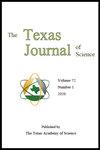瓜达卢佩河大肠杆菌遗传多样性的初步分析:粪便污染追踪的初步方法
Q4 Agricultural and Biological Sciences
引用次数: 0
摘要
从2016年冬季到2017年春季,对瓜达卢佩河的四个地点进行了大肠菌群采样,以评估该河的微生物污染状况并确定污染源。检测到的假定大肠菌群数量从低于检测限到每100毫升260 CFU不等。在采样期间,大肠菌群水平表现出强烈的季节性,可能与采样日期前的降雨量有关。对已确认的大肠杆菌分离株的分子分析表明,2016年12月3日大肠菌群数量的峰值仅由两个独特的指纹主导,这表明城市地区可能存在粪便污染的分水岭来源。河流农村地区大肠杆菌指纹的多样性要大得多,这表明大肠杆菌的来源多种多样,可能包括野生动物。需要进一步的研究来确定和管理粪便污染的来源。本文章由计算机程序翻译,如有差异,请以英文原文为准。
PRELIMINARY ANALYSIS OF E. COLI GENETIC DIVERSITY IN THE GUADALUPE RIVER: INITIAL APPROACH TO FECAL POLLUTION TRACKING
Four sites in the Guadalupe River were sampled for coliform bacteria from the winter 2016 through spring 2017 to assess the microbiological pollution situation in the river and to identify pollution sources. Numbers of putative coliforms detected ranged from below detection limits to 260 CFUs per 100 mL. Over the time period sampled, coliform levels exhibited strong seasonality, probably linked to the amount of rainfall prior to the sampling date. Molecular analysis of confirmed E. coli isolates demonstrated that the spike in coliform numbers 03 December 2016 was dominated by only two unique fingerprints, suggesting the possibility of a watershed source for fecal contamination in the urban area. The diversity of E. coli fingerprints was much greater in the rural portion of the river, suggesting a variety of coliform sources, probably including wildlife. Further studies are needed to identify and manage sources of fecal pollution.
求助全文
通过发布文献求助,成功后即可免费获取论文全文。
去求助
来源期刊

The Texas Journal of Science
Agricultural and Biological Sciences-Ecology, Evolution, Behavior and Systematics
CiteScore
0.50
自引率
0.00%
发文量
2
期刊介绍:
Scholarly manuscripts reporting original research results in any field of science or technology, including science education, will be considered for publication in The Texas Journal of Science. Prior to acceptance, each manuscript will be reviewed by both knowledgeable peers and the editorial staff. Authors are encouraged to suggest the names and addresses of two potential reviewers to the Manuscript Editor at the time of submission of their manuscript.
 求助内容:
求助内容: 应助结果提醒方式:
应助结果提醒方式:


